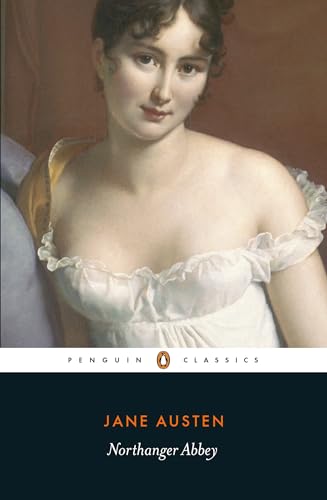Welcome to my review of Jane Austen’s “Northanger Abbey.” This charming novel cleverly blends satire, romance, and social commentary. It’s a delightful read where Gothic novel tropes meet Austen’s wit. Ready for an adventure? Let’s start!
In a nutshell
“Northanger Abbey” is a delightful novel by Jane Austen. This book mixes satire with romance. It pokes fun at Gothic novels, a popular genre of its time. As you read, you’ll follow the journey of the young and naive Catherine Morland. She’s an avid reader of Gothic novels herself. Catherine finds herself swept into a world where reality and imagination blend.
The book explores themes like the dangers of letting one’s imagination run wild. It also delves into the societal expectations of young women. There’s charm, wit, and a pinch of suspense. Austen takes a lighthearted approach while making sharp critiques of societal norms. It’s a must-read for fans of classic literature with a humorous twist.
The Quirky Satire of Gothic Novels in Northanger Abbey
So, I call myself a seasoned bookworm. I gobble up stories like candy. I like it even better when they make me laugh. That’s why “Northanger Abbey” by Jane Austen tickled my funny bone like no other! Austen playfully pokes fun at Gothic novels, which were the rage back in her day. I mean, who could resist a bit of mystery and drama?
Our heroine, Catherine Morland, gets wrapped up in spooky stories in Northanger Abbey. While reading, you can almost see Austen winking at you from behind the pages. It’s like she’s saying, “Look at how ridiculous all this melodrama is!” Catherine lets her imagination run wild when she stays at the abbey. I’d have done the same if I were in her shoes. It’s dark and gloomy, and well, aren’t all bad Gothic mysteries set there?
My friends and I once planned a supposed ‘ghost hunt.’ We jumped at every creek and rustling leaf, imagining sinister plots. Like Catherine, reality hit us square on the jaw as we found nothing more than a nosy squirrel. Austen cleverly shows how reality often defies our wild, spooky imagination. This satire is both eye-opening and highly entertaining. It’s like she’s giving a gentle nudge to all Gothic fans (myself included!).
In the next section, I will chat about the fascinating character development in “Northanger Abbey,” where not all characters are what they seem!
Character Development in Northanger Abbey
Jane Austen does an excellent job with character development in Northanger Abbey. I can’t help but chuckle at how she brings Catherine Morland to life. Starting as an imaginative 17-year-old, Catherine is obsessed with Gothic novels. I can relate, as I once believed I could fight dragons after reading a fantasy series. But Austen lets us see how Catherine grows from a naive girl to a young woman who learns to distinguish between fiction and reality. If only I had known there were no dragons before I scared the neighbors with my sword-fighting skills.
Austen uses characters like Henry Tilney to show Catherine—and readers—some real-life perspective. Henry is witty and charming, making him a fan favorite. Who doesn’t love a fellow who jokes about laundry lists? He’s like that friend who lightens up awkward family dinners. Henry’s influence on Catherine helps her recognize her tendency to let imagination cloud judgment. As she develops, she understands how trust and honesty build real relationships.
The other characters in the story, such as the Thorpes and the Allens, serve to highlight Catherine’s growth. They act as contrasts to her earnestness and are involved in humorous situations that emphasize her development. It’s like the time my dog was the only one brave enough to rescue a slice of pizza from the top of the fridge—sometimes, you need the right motivation to change!
Stay tuned to find out how Austen tackles the hefty themes of social expectations, as artfully as one might juggle flaming torches—while riding a unicycle!
Social Expectations in Northanger Abbey: Balancing Reality and Illusion
Let’s talk about social expectations! In Northanger Abbey, Jane Austen cleverly explores the impact of societal norms on individuals. Our protagonist, Catherine Morland, finds herself caught between what society expects and her own desires. It’s like being stuck between a rock and a hard place, but instead of a rock, you have a glamorous ball, and instead of a hard place, you have a strict chaperone!
Catherine goes to Bath and experiences the thrill and also the absurdity of high society. She discovers that social etiquettes can be as confusing as a walrus bowtie (not that I’ve ever seen one). The expectations placed on women of that time are particularly emphasized. Catherine must learn to navigate the treacherous waters of social gatherings and figure out who her real friends are without the aid of a GPS or Google Maps.
The contrast between reality and the illusions created by social norms is brilliantly illustrated in her interactions with the Thorpes and the Tilneys. While the Thorpes often showcase the superficial side of society, the Tilneys present a more genuine approach. It’s a virtual game of snakes and ladders, where one wrong move could land Catherine a slippery ride down.
Austen uses Catherine’s journey to humorously highlight how societal pressures can shape one’s identity. She brings out the absurdity in the expectations that were placed on young women at the time. Her satire is sharper than my uncle’s wit at Thanksgiving dinner!
Next, prepare to swoon as we unravel the tangled web of romantic elements dancing through the corridors of Northanger Abbey. Grab a cup of cocoa; it’s about to get romantic!
Romance in Northanger Abbey: A Comedic and Realistic Exploration
Ah, romance! It’s the stuff that makes hearts beat faster and eyes twinkle a little brighter. In Northanger Abbey, Jane Austen takes us on a rollercoaster of romance, cleverly wrapped in her signature wit. Unlike the sweeping, dramatic romances of her Gothic novel contemporaries, Austen presents a love story that feels real and relatable, with a touch of humor.
Our heroine, Catherine Morland, embarks on her romantic journey with the charming and oh-so-funny Henry Tilney. From the moment they meet, sparks fly, but not in the firework sense. It’s more like the spark you feel when someone gets your joke. You know, the ones your family never laughs at. Henry’s teasing banter and Catherine’s earnestness create a delightful push-pull dynamic that keeps readers grinning throughout. During their walks and dances, there’s chemistry, sure, but there’s also growth. Catherine learns about love, not just through heart-flutter moments but through understanding and mutual respect.
One of the best things about the romance in Northanger Abbey is its grounding in reality. Austen doesn’t rely on dramatic gestures or unrealistic portrayals. Instead, she skillfully shows the evolution of a young girl’s heart through genuine interactions. It’s refreshing, it’s funny, and it’s got just the right amount of swoon.
Would I recommend Northanger Abbey for its romantic elements? Absolutely! Austen serves a romance that’s as satisfying as a warm cup of tea on a rainy day—with a biscuit on the side for laughs.
Conclusion
In wrapping up this review, ‘Northanger Abbey’ cleverly satirizes Gothic tropes while crafting a fun and insightful tale. Catherine’s growth, the witty romantic elements, and social commentary make it a delightful read. Sure, there are moments when the pace slacks, but the humor and sharp observations keep you engaged. For those seeking a light-hearted yet meaningful Austen classic, this book is a great choice.


